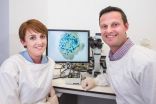(Press-News.org) July 29, 2014 – A simplified anesthesia procedure may enable more widespread use of preoperative testing to demonstrate the cause of airway obstruction in patients with severe sleep apnea, suggests a study in Anesthesia & Analgesia.
Dr. Joshua H. Atkins and Dr. Jeff E. Mandel of the University of Pennsylvania and their colleagues have developed a new "ramp control" anesthetic technique for putting patients to sleep briefly-just enough to show the "obstructive anatomy" responsible for sleep apnea. The simplified technique requires no special expertise and limits drops in blood oxygen level during testing.
Simplified Approach to Testing Before Apnea Surgery
The researchers evaluated their anesthetic technique in 97 patients participating in a study of robot-assisted surgery for severe sleep apnea. Visualizing the site of the obstruction in the upper airway is an important part of planning for apnea surgery. This can be done using a procedure called "drug-induced sleep endoscopy" (DISE), in which stepwise doses of anesthetic doses are given to put the patient to sleep and reproduce the airway obstruction causing apnea.
However, it's challenging to achieve just the right anesthetic dosage—enough to cause typical sleep-related obstruction without causing prolonged unconsciousness or causing a deep drop in blood oxygen level (oxygen saturation). The standard technique for DISE is time-consuming and not well-suited for widespread clinical use.
In the new ramp control approach, a computerized algorithm is used to calculate the two-dose sequence of anesthetic administration likely to produce sedation in each individual patient. By contrast, the standard stepwise approach to DISE uses a sequence of up to nine doses.
The 97 patients studied had severe sleep apnea, with a median of 48 apnea-hypopnea events (complete or partial interruptions of breathing) per hour on standard testing in the sleep laboratory. The patients were being evaluated for surgery after receiving no benefit from continuous positive airway pressure (CPAP), the standard treatment for sleep apnea.
The ramp-control DISE approach allowed doctors to see and photograph the obstructive anatomy in all 97 patients. The median time to put the patient to sleep and demonstrate the cause of obstruction was just under four minutes.
Just as important, the necessary level of sedation was achieved without an undue drop in oxygen saturation levels. The median lowest oxygen saturation level during DISE was about 91 percent, compared to an 81 percent value recorded in standard sleep studies. (Normal oxygen saturation is between 95 and 100 percent.)
Two-Dose Technique May Promote Wider Use of DISE
Although it's not new, DISE is still considered a "niche procedure"—not commonly performed by most anesthesiologists. It's easy to "overshoot" the anesthetic dose; this may lead to drops in oxygen saturation, requiring airway support steps to maintain the patient's blood oxygen level. Dr Atkins and colleagues note that their study included a "challenging" population of obese patients with severe sleep apnea, who have often been excluded from studies of other anesthetic techniques for sleep apnea.
The ramp-control DISE technique is efficient, administering just enough anesthetic to produce the desired level of sedation within a few minutes; and safe, with relatively small drops in blood oxygen saturation level. "The effective sedation seen in this study with a low rate of desaturation and infrequent need for airway support is an important result," Dr Atkins and coauthors write.
By simplifying the steps to anesthesia administration, the researchers believe their simplified approach will help to make DISE more widely available for evaluation of patients being considered for sleep apnea surgery. However, more research will be needed to determine how well the new technique can be generalized to everyday clinical practice at busy surgical centers.
INFORMATION:
Read the article in Anesthesia & Analgesia.
About Anesthesia & Analgesia
Anesthesia & Analgesia was founded in 1922 and was issued bi-monthly until 1980, when it became a monthly publication. A&A is the leading journal for anesthesia clinicians and researchers and includes more than 500 articles annually in all areas related to anesthesia and analgesia, such as cardiovascular anesthesiology, patient safety, anesthetic pharmacology, and pain management. The journal is published on behalf of the IARS by Lippincott Williams & Wilkins (LWW), a division of Wolters Kluwer Health.
About the IARS
The International Anesthesia Research Society is a nonpolitical, not-for-profit medical society founded in 1922 to advance and support scientific research and education related to anesthesia, and to improve patient care through basic research. The IARS contributes nearly $1 million annually to fund anesthesia research; provides a forum for anesthesiology leaders to share information and ideas; maintains a worldwide membership of more than 15,000 physicians, physician residents, and others with doctoral degrees, as well as health professionals in anesthesia related practice; sponsors the SmartTots initiative in partnership with the FDA; and publishes the monthly journal Anesthesia & Analgesia in print and online.
About Wolters Kluwer Health
Wolters Kluwer Health is a leading global provider of information, business intelligence and point-of-care solutions for the healthcare industry. Serving more than 150 countries worldwide, clinicians rely on Wolters Kluwer Health's market leading information-enabled tools and software solutions throughout their professional careers from training to research to practice. Major brands include Health Language®, Lexicomp®, Lippincott Williams & Wilkins, Medicom®, Medknow, Ovid®, Pharmacy OneSource®, ProVation® Medical and UpToDate®.
Wolters Kluwer Health is part of Wolters Kluwer, a market-leading global information services company. Wolters Kluwer had 2013 annual revenues of €3.6 billion ($4.7 billion), employs approximately 19,000 people worldwide, and maintains operations in over 40 countries across Europe, North America, Asia Pacific, and Latin America. Follow our official Twitter handle: @WKHealth.
New anesthesia technique helps show cause of obstruction in sleep apnea
'Ramp control' algorithm simplifies preoperative test for patients with severe sleep apnea
2014-07-29
ELSE PRESS RELEASES FROM THIS DATE:
Mysterious esophagus disease is autoimmune after all
2014-07-29
Achalasia is a rare disease – it affects 1 in 100,000 people – characterized by a loss of nerve cells in the esophageal wall. While its cause remains unknown, a new study by a team of researchers at KU Leuven in Belgium, the University of Bonn in Germany and other European institutions confirms for the first time that achalasia is autoimmune in origin. The study, published on 6 July in Nature Genetics, is an important step towards unraveling the mysterious disease.
When we swallow, a sphincter in the lower esophagus opens, allowing food to enter the stomach. Nerve cells ...
Worldwide water shortage by 2040
2014-07-29
Two new reports that focus on the global electricity water nexus have just been published. Three years of research show that by the year 2040 there will not be enough water in the world to quench the thirst of the world population and keep the current energy and power solutions going if we continue doing what we are doing today. It is a clash of competing necessities, between drinking water and energy demand. Behind the research is a group of researchers from Aarhus University in Denmark, Vermont Law School and CNA Corporation in the US.
In most countries, electricity ...
Mortality rates increase due to extreme heat and cold
2014-07-29
Epidemiological studies have repeatedly shown that death rates rise in association with extremely hot weather. The heat wave in Western Europe in the summer of 2003, for example, resulted in about 22,000 extra deaths. A team of researchers led by Dr. Alex-andra Schneider at the Institute of Epidemiology II at the Helmholtz Zentrum München examined the impact of extreme temperatures on the number of deaths caused by cardiovascular disease in three Bavarian cities and included both high and low temperatures in the study.
"Our findings confirm the results of our previous ...
A new brain-based marker of stress susceptibility
2014-07-29
DURHAM, N.C. -- Some people can handle stressful situations better than others, and it's not all in their genes: Even identical twins show differences in how they respond.
Researchers have identified a specific electrical pattern in the brains of genetically identical mice that predicts how well individual animals will fare in stressful situations.
The findings, published July 29 in Nature Communications, may eventually help researchers prevent potential consequences of chronic stress -- such as post-traumatic stress disorder, depression and other psychiatric disorders ...
First grade reading suffers in segregated schools
2014-07-29
A groundbreaking study from the Frank Porter Graham Child Development Institute (FPG) has found that African-American students in first grade experience smaller gains in reading when they attend segregated schools—but the students' backgrounds likely are not the cause of the differences.
According to the Center for Civil Rights, although the United States is becoming more racially and ethnically diverse, segregation is still on the rise. To better understand segregation's impact on student performance, FPG scientists looked at nearly 4000 first graders in public schools ...
Local education politics 'far from dead'
2014-07-29
EAST LANSING, Mich. --- Teach for America, known for recruiting teachers, is also setting its sights on capturing school board seats across the nation. Surprisingly, however, political candidates from the program aren't just pushing its national education agenda, they're advancing local issues as well, according to a new study.
The findings, said Michigan State University's Rebecca Jacobsen, refute the argument that school boards have become ineffective and obsolete in the wake of national education reform. Teach for America, a nonprofit that enlists high-achieving college ...
Wildfires continue near Yellowknife, Canada
2014-07-29
The wildfires that have been plaguing the Northern Territories in Canada and have sent smoke drifting down to the Great Lakes in the U.S. continue on. NASA's Aqua satellite collected this natural-color image with the Moderate Resolution Imaging Spectroradiometer, MODIS, instrument on July 26, 2014. Actively burning areas, detected by MODIS's thermal bands, are outlined in red. Copious amount of smoke are drifting northward in this image. Smoke is also creating havoc for residents of Yellowknife. Fire has caused power outages in the area and because of the smoke, line ...
Stem cell advance may increase efficiency of tissue regeneration
2014-07-29
A new stem-cell discovery might one day lead to a more streamlined process for obtaining stem cells, which in turn could be used in the development of replacement tissue for failing body parts, according to UC San Francisco scientists who reported the findings in the current edition of Cell.
The work builds on a strategy that involves reprogramming adult cells back to an embryonic state in which they again have the potential to become any type of cell.
The efficiency of this process may soon increase thanks to the scientists' identification of biochemical pathways ...
New research reveals Pele is powerful, even in the sky
2014-07-29
One might assume that a tropical storm moving through volcanic smog (vog) would sweep up the tainted air and march on, unchanged. However, a recent study from atmospheric scientists at the University of Hawai'i – Mānoa (UHM) revealed that, though microscopic, gasses and particles from Kilauea volcano exerted an influence on Tropical Storm Flossie – affecting the formation of thunderstorms and lightning in the sizeable storm.
In July 2013, as Flossie approached the Hawaiian Islands, satellites steadily monitored lightning, rainfall, cloud cover, temperature and ...
Herpes remains active even when no symptoms appear
2014-07-29
Scientists investigating the herpes virus have been surprised to find an ongoing conflict in the cells of sufferers, even when the virus is apparently dormant.
Herpes Simplex Type 1 is a virus that causes cold sores. It remains in the body's nervous system indefinitely after infection. Around 80 per cent of Australians carry the virus, although it is usually in a dormant state.
"We thought when the disease was dormant, it was a truce," said Associate Professor David Tscharke from The Australian National University Research School of Biology. "It turns out that the virus ...
LAST 30 PRESS RELEASES:
Three UH Rainbow Babies & Children’s faculty elected to prestigious American Pediatric Society
Tunnel resilience models unveiled to aid post-earthquake recovery
Satellite communication systems: the future of 5G/6G connectivity
Space computing power networks: a new frontier for satellite technologies
Experiments advance potential of protein that makes hydrogen sulfide as a therapeutic target for Alzheimer’s disease
Examining private equity’s role in fertility care
Current Molecular Pharmacology achieves a landmark: real-time CiteScore advances to 7.2
Skeletal muscle epigenetic clocks developed using postmortem tissue from an Asian population
Estimating unemployment rates with social media data
Climate policies can backfire by eroding “green” values, study finds
Too much screen time too soon? A*STAR study links infant screen exposure to brain changes and teen anxiety
Global psychiatry mourns Professor Dan Stein, visionary who transformed mental health science across Africa and beyond
KIST develops eco-friendly palladium recovery technology to safeguard resource security
Statins significantly reduce mortality risk for adults with diabetes, regardless of cardiovascular risk
Brain immune cells may drive more damage in females than males with Alzheimer’s
Evidence-based recommendations empower clinicians to manage epilepsy in pregnancy
Fungus turns bark beetles’ defenses against them
There are new antivirals being tested for herpesviruses. Scientists now know how they work
CDI scientist, colleagues author review of global burden of fungus Candida auris
How does stroke influence speech comprehension?
B cells transiently unlock their plasticity, risking lymphoma development
Advanced AI dodel predicts spoken language outcomes in deaf children after cochlear implants
Multimodal imaging-based cerebral blood flow prediction model development in simulated microgravity
Accelerated streaming subgraph matching framework is faster, more robust, and scalable
Gestational diabetes rose every year in the US since 2016
OHSU researchers find breast cancer drug boosts leukemia treatment
Fear and medical misinformation regarding risk of progression or recurrence among patients with breast cancer
Glucagonlike peptide-1 receptor agonists and asthma risk in adolescents with obesity
Reviving dormant immunity: Millimeter waves reprogram the immunosuppressive microenvironment to potentiate immunotherapy without obvious side effects
Safety decision-making for autonomous vehicles integrating passenger physiological states by fNIRS
[Press-News.org] New anesthesia technique helps show cause of obstruction in sleep apnea'Ramp control' algorithm simplifies preoperative test for patients with severe sleep apnea



